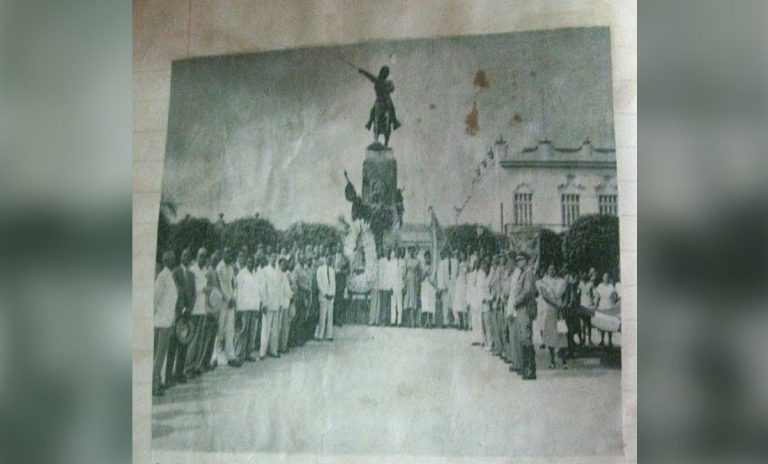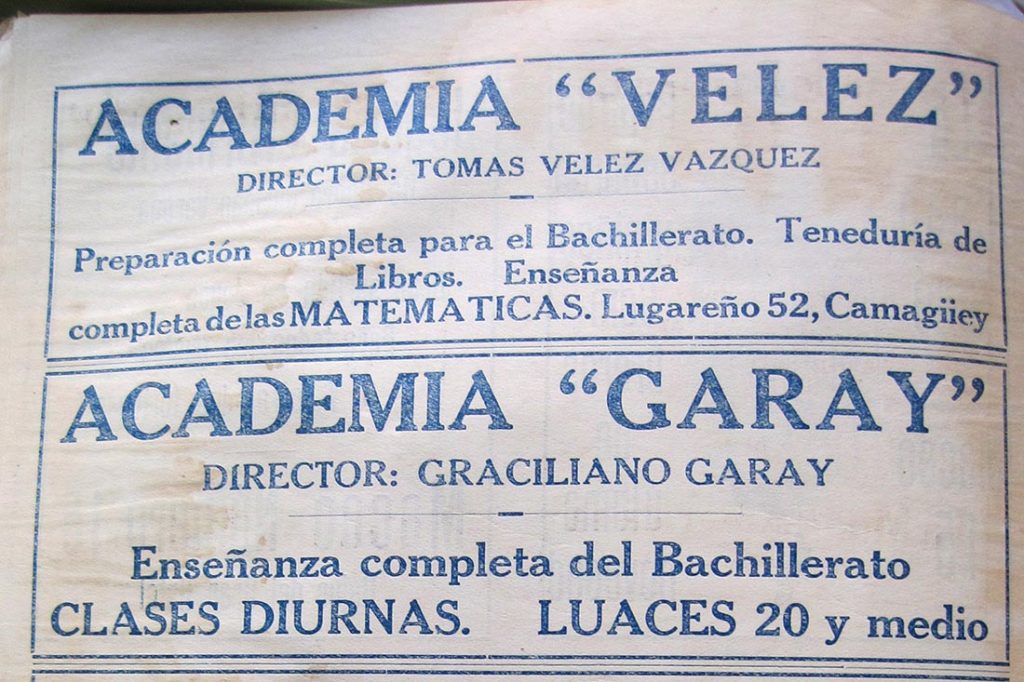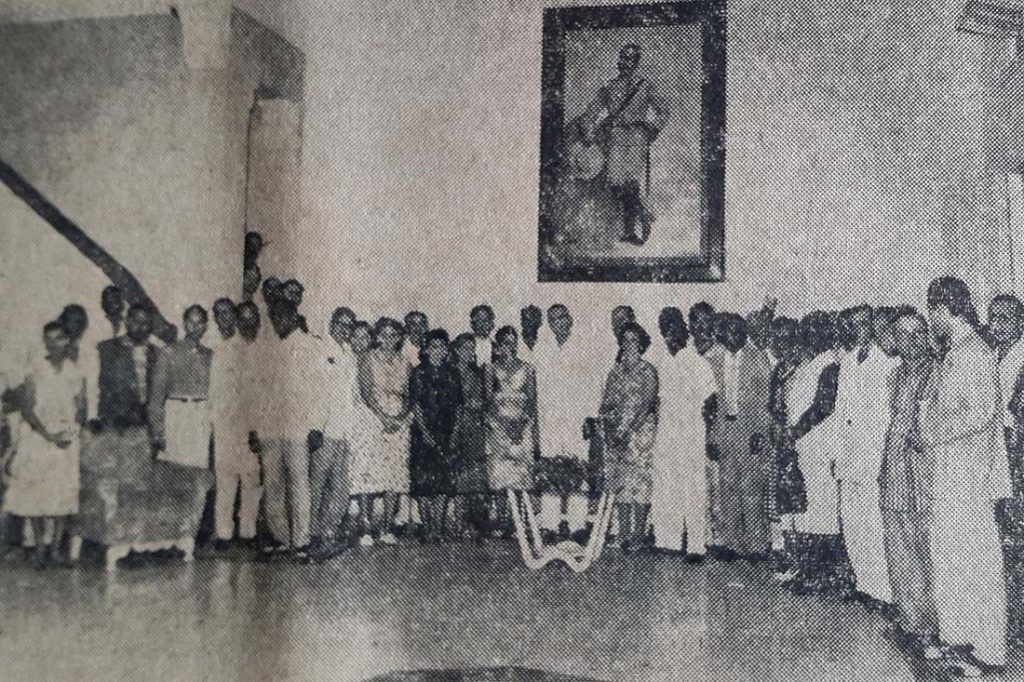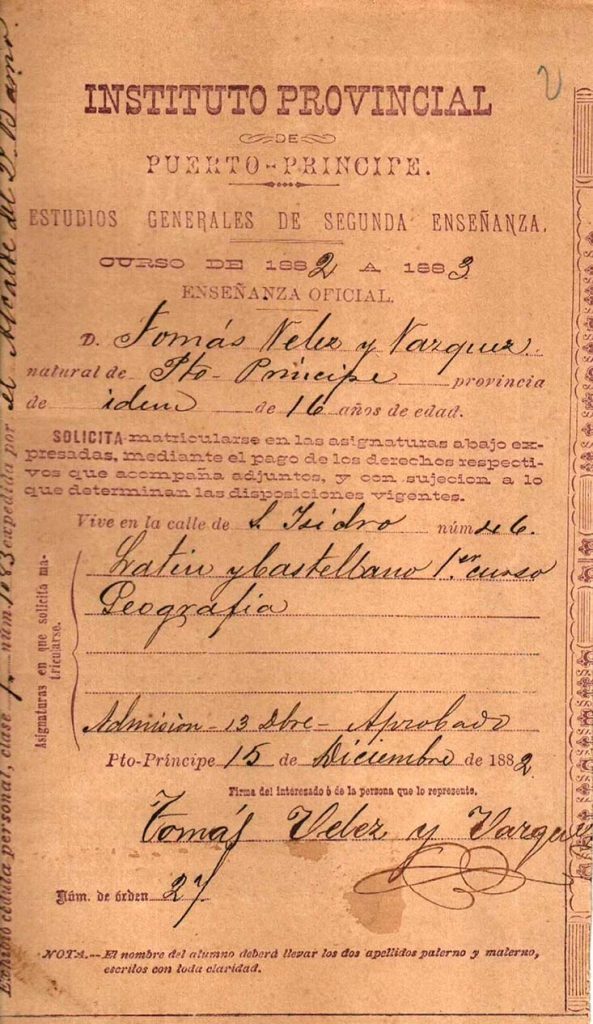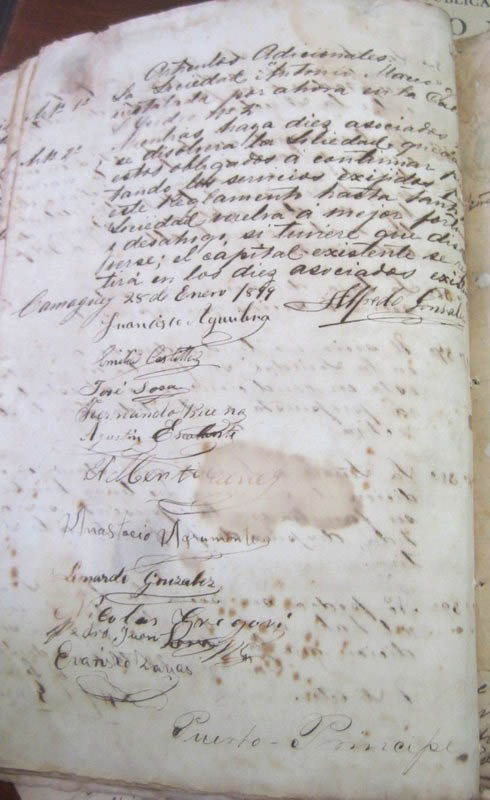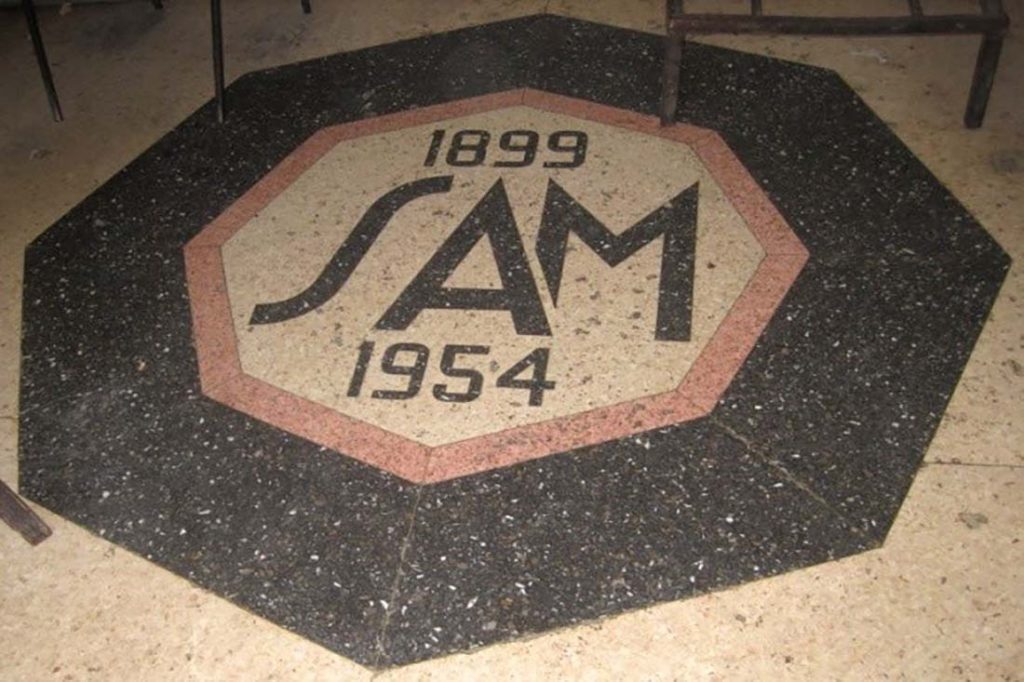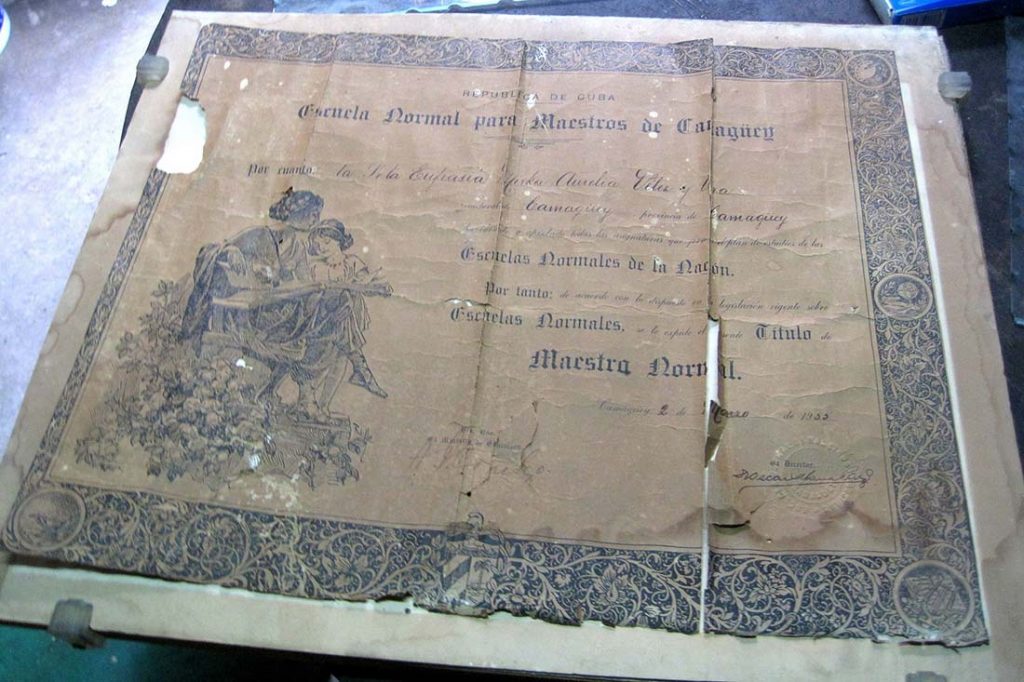By: Dra.C. Kezia Zabrina Henry Knight
In 1899, in the middle of the North American occupation, a group of black and mestizo citizens of Camagüey decided to honor Major General Antonio Maceo Grajales with a namesake and distinctive association, founded on January 15th, 1899 by Messrs. Francisco Aguilera (president), Alfredo González Betancourt (secretary), Emilio Castillo, José Sosa, Fernando Bueno, Agustín Escalante, Alberto Canes, Anastasio Agramonte, Leonardo González, Nicolás Gregorí, Pedro Juan Lara and Evaristo Lara.
On January 28th, the Regulations were presented to the Provincial Government with 39 articles and two additional ones, and on November 10th, 1899 it was approved.
Along with the dates we count…
The first article specifies his title: Antonio Maceo, which would be under the protection of the government, the second limits its corporate purpose: to provide its partners with instruction and legal entertainment, prohibiting any discussion and any kind of game or any matter that could alter the union and harmony that must rule as the fundamental basis of any well-organized society; and it will be private.
The first additional article states that at that time the institution was moved into San Isidro No. 2 and the second that, as long as there are 10 associates, the association will not be dissolved.
In 1903, the premises were already located at 68 Lugareño street with Alberto Canes as president and Joaquín P. Socarrás, secretary. The provincial Governor signed the approval of the modified regulation on January 27th, now with 41 articles. While in 1915 it was already settle in Goyo Benítez (Príncipe) Street No. 10 until 1961.
Who they were?
In its original bosom the surviving mambises of the war of 1895 settled, who had united in 1893 in the Victoria Club. At the end of the war they reorganized under a new nomination: Antonio Maceo in 1899 and in the Victoria association in 1904.
Thus, these associations, the most influential ones, originated from a mambí and counter-hegemonic lineage, of rebellion to the colonial system and against social exclusion and multiple discrimination, mainly due to skin color.
Mechanisms established for entry, membership and permanence in the association
The assembly was the one who proposed and approved the directive, usually every two years. It also established the entry fee and the monthly fee under a consensual approval.
2.00 pesos was approved as the monthly fee, which limited access for those who did not have economic stability. Males applied for membership at the age of 16; while the girls were introduced by their father or older brother at the age of 15. The order was established from a social behavior in accordance with the morality of the time and was monitored with sanctions in case of indiscipline inside or outside the institution, since their permanence in the halls of the Maceo was curtailed.
In this sense, the contractual approval was both internal and external, since after its legal-governmental approval it was an official part of the Register of associations of the province and the nation.
The statutes were modified and expanded in accordance with the highest demands that were proposed as a group and in accordance with the contexts. His motto was: “For our black race, for the greatest decorum of Cuba.”
The purposes were to expand the intellectual, moral and physical faculties of its members and families.
Counter-hegemonic educational practices and its contributions
The members of this association fostered educational practices that achieved a counter-hegemonic performance. They founded egalitarian educational institutions for both sexes of First education such as that of the spouses: Abad Jiménez, Padre Valencia, 53; that of Tomás Vélez Betancourt (son), Raúl Lamar 14.F
Also of second education such as those of Tomás Vélez Vázquez (father), Lugareño 52 and at night in the Callejón de la Risa where Nicolás Guillén studied, among other students of the time due to their socially weighted prestige.
Those of languages, English and French and the free night academies for workers and housewives enabled those excluded from the educational system at different times to receive the bread of education.
In these latent educational networks promoted by the members of this association, the founding of educational institutions for both sexes directed by women with doctorates in Pedagogy at the University of Havana such as that of Surama Varona Guzmán, 20 de Mayo no. 73 and the Carnesoltas Sisters, 10 de Octubre Street.
They fostered an emancipated social representation of black women in terms of their autonomy, insofar as the ability to generate income and their own resources, refers to economic autonomy, and full participation in decision-making that affect their lives and their community, We speak of autonomy in decision-making; in addition to being the bearer of that power in front of other people to be listened to and respected.
These women are placed in the reference and the achievement of goals for those who have not come out of precariousness and mental slavery rather than economic, either due to deficiencies in the social structure, also lack of family goals, psychosocial context.
These owners of Academies are socially powerful women, due to respect, consideration in general. In addition, the presence of a university teaching profession institutionalized by independent black women, taking into account the socio-historical conditioning determinants mentioned above, models counter-hegemonic educational practices and fosters a culture of equity, justice and social inclusion.
In this sense, the educational press directed by members of this association, at the same time, the library and the presence of university lecturers in a systematized way, alternatively developed the instructional level of families on cultural, medical, legal, civic-moral, scientific, artistic, ethnic, anthropological, political issues, and also demands for equity and social inclusion. They also created alternative curricular materials with stories of the black-mestizo mambisado, the emergence and development of its cultural and historical spaces and leaders silenced by the official history of the nation.
Examples: “Memories and ideals of Gustavo Caballero A.”; “Alberto Morales Casalís”; “Abelardo Mola”, “José del Pilar Páez Silva”, “Quintín Banderas and Betancourt”; “José María Zúñiga”; “Commander Aniceto Recio”, the latter survivor of Julio Sanguily’s rescuers, among other Afro-descendant mambises who are part of the Veterans of the Wars of Independence gallery that were systematized in the Antonio Maceo halls.
Other alternative educational practices
On the other hand, the mutual help they practiced among themselves also constituted a way of cultivating and teaching solidarity as a value.
Those in need received medicine, food, funeral services for members and their families. The foundation of a popular sanatorium for the members was planned, but , was not fully accomplished, but the help to the needy acted as the currency of these social practices.
On the charitable aid platform some of the children of the associates were able to enroll in the Institute of Second Education and then opt for university studies at the University of Havana and even abroad as Apolinario Chávez Socarrás who went to study Plastic Arts in Rome; Fernando Bastián Milan studied Medicine in France, at the Sorbonne University, Paris; Olga Porro Miranda, José Jiménez Mesa and Roa Caballero del Risco, finished their medical studies in Spain, at the Universities of Madrid and Valencia.
Likewise, mutual aid promoted in the professional directories of their own and local periodicals, medical and legal consultations, of expert midwives, private academies, pharmacies, private schools, funeral homes, flower shops, sawmills, carpenter’s shops, shoe stores, that is to say, all kinds of businesses whose owners were associates and a large part of the clientele was in these associative networks.
The association led artistic-literary evenings not only in their halls; also in the houses of the most recognized families, the Vélez, Páez, Abad, Bastián, Guillén, Carnesoltas, Valero, Napoles, Carbonell and others.
It was also distinguished by the activities carried out on December 7th, a sad date for the fall of the Bronze Titan Antonio Maceo of national historical significance, even in other countries.
In 1951, the board of directors organized a memorable ceremony at the Main Theater of the city at 8 pm with the presence of personalities such as José Maceo, grandson of Major General José Maceo Grajales.
The opening of the program was in charge of Dr. Eulalio Páez Sedano, president of the institution, the poems by the young Migdalia Páez Hernández and Mrs. Luz de los Ángeles Gómez Alfaro (First Prize in Competition at the Principal Theater, 1937), the Municipal Band performed patriotic songs, the greeting to the people of Camagüey was pronounced by José Maceo; reaffirmed by a representative of the Haitian consulate, Mr. Charles [sic], Dr. Demetrio Carbonell Céspedes introduced Dr. Pedro E. Abad Jiménez, the eulogist of the night, who gave the lecture Antonio Maceo and his revolutionary ideal, sealed with great ovation.
In the interconnection with the social system, the Maceo association promotes the transformation of the Plaza de Paula for its conversion into the Plaza Maceo, just to mark the commemorations of the centenary of the birth of the Bronze Titan, Antonio Maceo and Grajales.
The Committee for the monument and commemoration of the centenary of Antonio Maceo is established, both represented by the City Council. The town is committed to the development of this process until the end of the placement and inauguration of the bronze bust.
The different social partners: associations, churches, private and state companies, private and public schools in the city offered well-deserved tribute to the Titan. Dr. Francisco Guillén Batista, director of the association and of the Antifascist Provincial Front in 1944 at the Ordinary General Meeting of the Antonio Maceo Association, on December 16th; in point four, this lawyer asks for the floor to:
[…] Propose to the Assembly to pass a telegram to the House of Representatives, the Senate of the Republic and the Honorable Mr. President of the Republic Dr. Ramón San Martín, so that as soon as possible and before the celebration of the Centenary of the Birth of Antonio Maceo, the complementary laws of the Constitution that guarantee the equality of all Cubans were approved by Congress and sanctioned by the President of the Republic. (Guillén, F. 1944).
Proposal that was approved unanimously. Likewise, Dr. Guillén stood out in the celebrations of the centenary of the birth of the Bronze Titan Antonio Maceo y Grajales and in the Committee for Monument and commemoration of the centenary of Antonio Maceo, both represented by the City Council.
The people committed to the development of this process until the end of the inauguration of the bronze bust revealed on Plaza Maceo.
In this educational sense, the association developed social and political actions on patriotic dates related to homeland freedoms: January 28th, February 24th, May 20th, October 10th, December 7th, among other civic commemorations in public spaces such as the central Parque Agramonte, Plaza Maceo, Casino Campestre.
Historical tours were carried out on these dates; floral offerings were deposited at the Ignacio Agramonte monument. In 1959, its members were part of the army of volunteer teachers and literacy tutors that the country demanded in different profiles until 1961, when Cuba declared itself illiteracy-free territory.
It is in 1961 when the place changed its social use.
Nowadays
The building structure, of the then pertinent Antonio Maceo association, is today a center for food processing, a social matter that raises concerns for the former members and relatives who built the building with their own money.
The interviewees express their interest in having its architectural decorum returned to a laudable sociocultural institution. On the other hand, the periodical publications directed by its members, documentary sources of exceptional value, do not appear in libraries or public archives. At the same time, the black-mestizo mambisado is invisible, who from the 10 Years’ War to that of ’95 gave his life for the independence of Cuba and also founded these associations of social transcendence and meritorious educational contributions in the Tregua Fecunda.
The present study can be assumed as an act of honor to these men and women who, in exclusionary and discriminatory contexts, defied structural obstacles and gave the best of themselves to their families, community and the country.
_______________
Bibliography
Henry Knight, K.Z. (2020): Asociaciones de instrucción y recreo de negros y mestizos. Contribución al desarrollo educativo y artístico en la sociedad de Camagüey (1879 – 1961). Tesis presentada en opción al grado científico de Doctor en Ciencias Sociológicas. Universidad de la Habana, Facultad de Filosofía, Historia y Sociología. Departamento de Sociología. República de Cuba.
Translated by: Aileen Álvarez García

